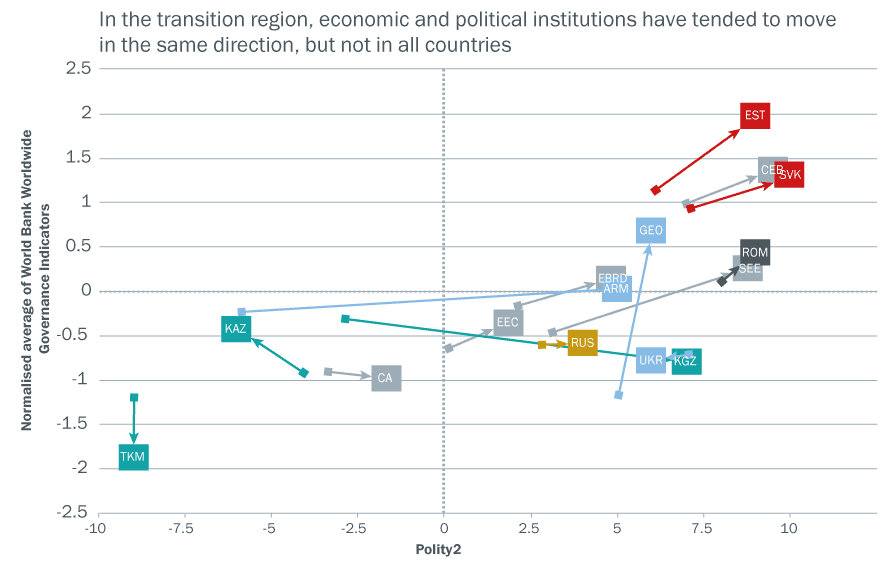Economic institutions
Forces shaping economic institutions - Democracy
- Details
- Economic institutions
Chapters 1 and 2 showed that democratic political institutions – as measured by the Polity2 indicator, which ranges from -10 to +10 – are correlated with the transition indicators. Similar correlations apply when the WGIs or the distance to the frontier are used to measure economic institutions – from about 0.34 in the case of the distance to the frontier up to 0.51 in the case of the indicator of regulatory quality, based on 2011 data for a large cross-section of countries.
There are several ways to interpret these correlations, which are not mutually exclusive. Consistent with the findings of Chapter 2, better economic institutions might foster economic development – and thus, over time, democracy. Alternatively (or in addition), the causality might run in the other direction. Political competition and the checks and balances that are characteristic of democracy might restrict the government’s ability to engage in expropriation and rent-seeking and lead to more business-friendly rules and regulations.1
Democratic regimes are also more likely to have an independent judiciary and regulatory bodies that serve a particular mandate, rather than the interests of ruling elites. The fact that the correlations between democracy and economic institutions are lower when the latter are measured using the distance to the frontier may reflect the fact that even less democratic countries can successfully improve aspects of the business environment when there is a political will to do so.
Chart 3.2 confirms that improvements in political and economic institutions have often gone hand in hand. With the exception of Central Asia, all transition regions (shown in grey) have moved upwards and rightwards on the chart, which shows the Polity2 measure on the horizontal axis and the average WGI on the vertical axis. That said, there are countries in which the development of economic institutions has far outpaced democratisation (Georgia), or vice versa (Armenia). There are also countries that have improved their political institutions, but not their economic ones (for instance, the Kyrgyz Republic). The opposite – improvements in economic institutions, but a decline in the level of democracy – appears to have happened in Kazakhstan.
The country experiences shown in Chart 3.2, as well as the fact that the correlations between democracy and economic institutions rarely exceed 0.5, suggest that there must be other factors shaping the quality of economic institutions. Understanding the potential influence of these other factors – and confirming that democracy remains a statistically significant influence on economic institutions even in their presence – requires a multivariate analysis.
Tables 3.1 and 3.2 contain the results of such analysis for a worldwide sample of 121 countries and 25 countries in the transition region respectively. Each column represents the result of one regression, which relates a measure of economic institutions to a set of potential explanatory factors. These factors include the Polity2 democracy measure, as well as measures of trade and financial openness, resource endowments, ethnic diversity, historical and geographical variables and (in some columns) per capita income. Table 3.1 focuses on either average WGIs (columns 1, 2 and 3) or the distance to the frontier (columns 4, 5 and 6), while Table 3.2 considers WGIs and transition indicators.2
One important concern in these regressions is to ensure that the coefficient for the Polity2 variable can be interpreted as the impact of democracy on economic institutions, rather than the other way around. The regressions aim to ensure this in two ways.
- First, most specifications include per capita income as a proxy of economic development.3 Hence, the coefficient for the Polity2 variable expresses the correlation between democracy and economic institutions for countries at comparable stages of development. This means that this correlation cannot be interpreted as reflecting the impact of economic institutions on democracy working through higher income.
- Second, the possibility of feedback from economic institutions to both democracy and per capita income is minimised through the regression techniques used. In the panel regressions, Polity2 (and all other time-varying variables) always enters with a one-period lag – that is to say, the average for the preceding three-year period is used. As an additional check, an alternative technique is used (“GMM”; see second column of Table 3.1) that effectively estimates the relationship in terms of changes, rather than the levels of the main variables, and rules out contemporaneous feedback.
The tables confirm that democracy appears to lead to better economic institutions, and that the effect is generally statistically significant in both the world and transition region samples.
When the distance to the frontier is used, the relationship loses its statistical significance, perhaps because this institutional measure only covers a six-year period. Moreover, the distance to the frontier index captures a narrower aspect of economic institutions, which is less closely related to democracy than broad WGI measures such as government effectiveness or the rule of law.
To interpret the size of the effect that democracy has on economic institutions, let us consider some countries with low scores on the Polity2 scale, such as Turkmenistan and Uzbekistan (rated -9 on the Polity2 scale), and others with very high scores, such as Poland, Lithuania, the Slovak Republic and Slovenia (all rated 10). The average WGI for the latter group is about 1.4, but it is -1.6 for the former – a three-point difference. The coefficient in the panel regressions (about 0.03) implies that the 19‑point difference on the Polity2 scale explains almost 0.60 point – about 20 per cent – of the difference in quality between the economic institutions in the two sets of countries.
Importantly, this merely captures the direct effect of democracy on economic institutions, keeping everything else constant. In particular, it does not reflect any effects through per capita income levels (with democratic institutions likely to lead to faster growth) or trade and financial openness, which are captured separately in the regression.
- See Olson (2000), North (1990) and North and Weingast (1989). [back]
- Because the WGIs and the distance to the frontier are available for different time periods (the latter only having been available since 2006), the regressions refer to different time periods. Furthermore, the short period of availability of the distance to the frontier implies that it can only be analysed using a cross-sectional regression. Because of the low number of transition countries, the distance to the frontier can only be analysed in the world sample. [back]
- To confirm the robustness of the results, each set of regressions contains one specification in which per capita income is not included.[back]














